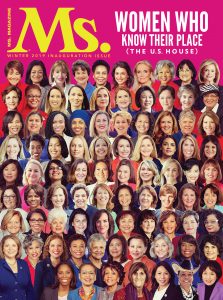 This post is excerpted from the latest issue of Ms.—our inauguration special, which introduces the new feminists in office this year. Many of them are being sworn in today.
This post is excerpted from the latest issue of Ms.—our inauguration special, which introduces the new feminists in office this year. Many of them are being sworn in today.
To read more from the issue, become a Ms. member today.
To meet the new feminists in town, click here.
Inspired by the massive Women’s March movement, encouraged by feminist organizations and energized by passionate volunteers, record numbers of women candidates—many of them first-timers—stepped forward to run for office in the midterm elections. And they won in historic numbers. Propelled by a gender gap as great as any in the past 20 years, led by women of color, young women and college-educated women, their collective victories in Congress, state legislatures and statewide offices lay the groundwork for even larger gains in 2020.
Victories by feminist women candidates shifted the balance of power in the House, accounting for more than 60 percent of Democrats’ gains. Many of these candidates defeated long-entrenched Republican incumbents, overcoming massively gerrymandered districts and voter suppression to flip the House from red to blue.
Republican losses were deep and wide: Overall, Democratic candidates earned 8.8 million more votes than Republicans. Of the 43 House seats that flipped, nearly half were in districts Donald Trump won in 2016. Democrats gained a net of 40 seats, losing three to Republican candidates. (At press time, one House race was yet to be called.) In the Senate, Jacky Rosen decisively beat Republican incumbent Dean Heller in Nevada. And Kyrsten Sinema won an open Senate seat in Arizona long held by Republicans. Historic breakthroughs define the newest incoming class of women: The first Native American women to be sworn into Congress. The first black congresswomen from New England states. The first Latinas to ever represent Texas in Congress. The first Muslim women.
Among the ranks of the new women taking their place in Washington, D.C., are social workers, teachers, military officers and veterans, judges, lawyers and refugees. A pediatrician will be the only woman among 16 doctors in Congress. There are experts on the homeless crisis, early childhood education and human trafficking. And a mother who lost her teenage son to gun violence.
The presence of more women in Congress will have important impacts on policy debates, given their different backgrounds and varied life experiences. They will bring much-needed perspectives and ideas to the ensuing battles over health care, reproductive rights, gun reform, immigration, the environment, voting rights, sexual harassment and assault, LGBTQ rights, military spending and foreign policy.
And to the fight for women’s equality.
As the new year got underway, feminist women were sworn in as governors in Maine, Kansas, Michigan and New Mexico. Women took office as secretaries of state in Colorado, Arizona and Michigan, and attorneys general in Michigan, New York and Delaware. In a first, all statewide executive offices in Michigan—governor, attorney general and secretary of state—are now held by women.
In state legislatures, women now hold 28 percent of seats, smashing previous records and bringing about the largest electoral gain in “more than a decade of relative stagnation,” according to Debbie Walsh, director of the Center for American Women and Politics at Rutgers University. In historic firsts, both the Nevada Assembly and Colorado House of Representatives will be gender balanced, with nearly equal numbers of women and men. A 19-year-old former Girl Scout who campaigned to end child marriage was elected to the state legislature in New Hampshire.
Public education was a major motivating issue for voters in state legislative races. Following teacher strikes and walkouts over cuts in education funding and inadequate teacher pay in Oklahoma, West Virginia, North Carolina, Colorado and Arizona, public school teachers ran for elective office in record numbers. More than 80 of the 300 members of the American Federation of Teachers who ran were ultimately elected to state legislatures, and a public school speech therapist in her early 30s won for Arizona superintendent of public instruction.
Voter turnout in the midterms was estimated at 50 percent of the voting eligible population—the highest rate in more than five decades. But it was women voters opposed to Donald Trump’s destructive policies who cast the decisive votes to break the Republican stranglehold on Congress. According to the national Edison Research exit poll, 59 percent of women voted for Democratic House candidates in races across the country, compared to 47 percent of men, a 12point gender gap. Among young (18 to 29-year-old) voters, 67 percent voted Democratic versus 32 percent who voted Republican.
As in 2016, the gender gap was driven by the “feminist factor” that we at Ms. first identified and defined during the 2012 elections. Ms. commissioned a poll conducted by Lake Research Partners Nov. 4–6, 2018. At the time, 56 percent of women voters and 36 percent of men voters self-identified as feminists. But among women voting for Democratic congressional candidates, 77 percent identified as feminists, as did 53 percent of men, compared to 33 and 23 percent of women and men, respectively, voting for Republican candidates.
A solid majority (57 percent) of younger women in the Ms./Lake Research poll identified as feminists, as did 55 percent of older women. The feminist factor cut across race and ethnic lines, with a majority of Latinas (62 percent), African American women (63 percent) and white women voters (54 percent) considering themselves feminists. A majority of married women (51 percent) and unmarried women (64 percent), as well as college-educated women (65 percent) and non-college-educated women (52 percent), said they consider themselves feminists.
Self-avowed feminist Nancy Pelosi is again the House Speaker, second in line to the presidency and the most powerful woman in government. Pelosi has said she intends to make women’s issues a priority, pushing forward long-stalled legislation to address the wage gap and sexual harassment. Despite having led the Democrats to a 40-seat gain in the midterms (a feat made infinitely more difficult by Republicans’ aggressively gerrymandered districts) and being ranked among “the most consequential speakers” in history by congressional scholar Norman Ornstein of the conservative American Enterprise Institute, Pelosi was forced to wage a campaign to beat back an effort led by Reps. Tim Ryan (D-Ohio) and Seth Moulton (D-Mass.) to push her aside for younger leadership.
Answering her critics, Pelosi told CNN, “None of us is indispensable, but some of us are just better at our jobs than others.” She added: “I want women to see that you do not get pushed around. You don’t run away from the fight.”
More committees in the 116th Congress than any previous will be headed by women. Rep. Nita Lowey (D-N.Y.) will chair the powerful Appropriations Committee. The first woman to chair Appropriations, she has listed among her priorities increasing funding for child care and early education programs and blocking Republican efforts to reduce spending on family planning. Rep. Maxine Waters (D-Calif.) will chair the Financial Services Committee. She has pledged to restore the Consumer Financial Protection Bureau and undo the Republican changes that weakened provisions of the Dodd-Frank Act meant to curb risky banking practices. Also among committee chairs will be Rep. Nydia Velázquez (D-N.Y.), who will chair the Small Business Committee, and Rep. Eddie Bernice Johnson (DTexas), who will chair the Science, Space and Technology Committee.
Yet despite the unprecedented gains this year in elective office, women remain woefully underrepresented in virtually every elected body. Women now constitute just 23.6 percent of members of Congress (106 Democrats and 20 Republicans). Going into the midterms, the U.S. ranked No. 103 worldwide in women’s representation in government, according to the Inter-Parliamentary Union.
“There is still a long way to go to equality,” observed Eleanor Smeal, president of the Feminist Majority and publisher of Ms. “But what the midterms proved is that more women candidates challenging reactionary incumbents and ‘flooding the ticket’ are successful strategies for making faster gains. No question about it: The pace of women winning is accelerating.”





